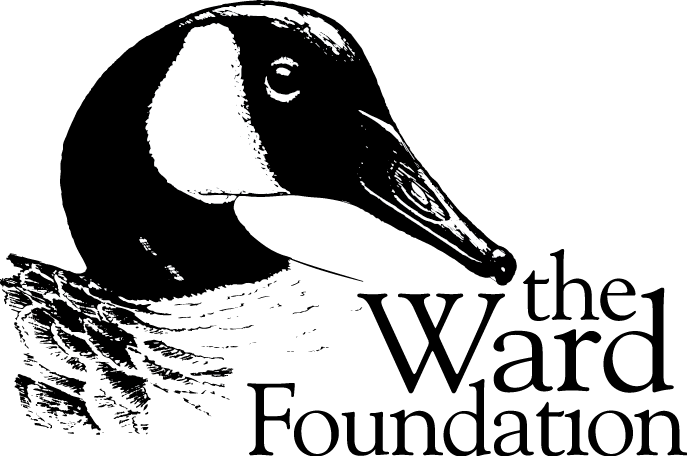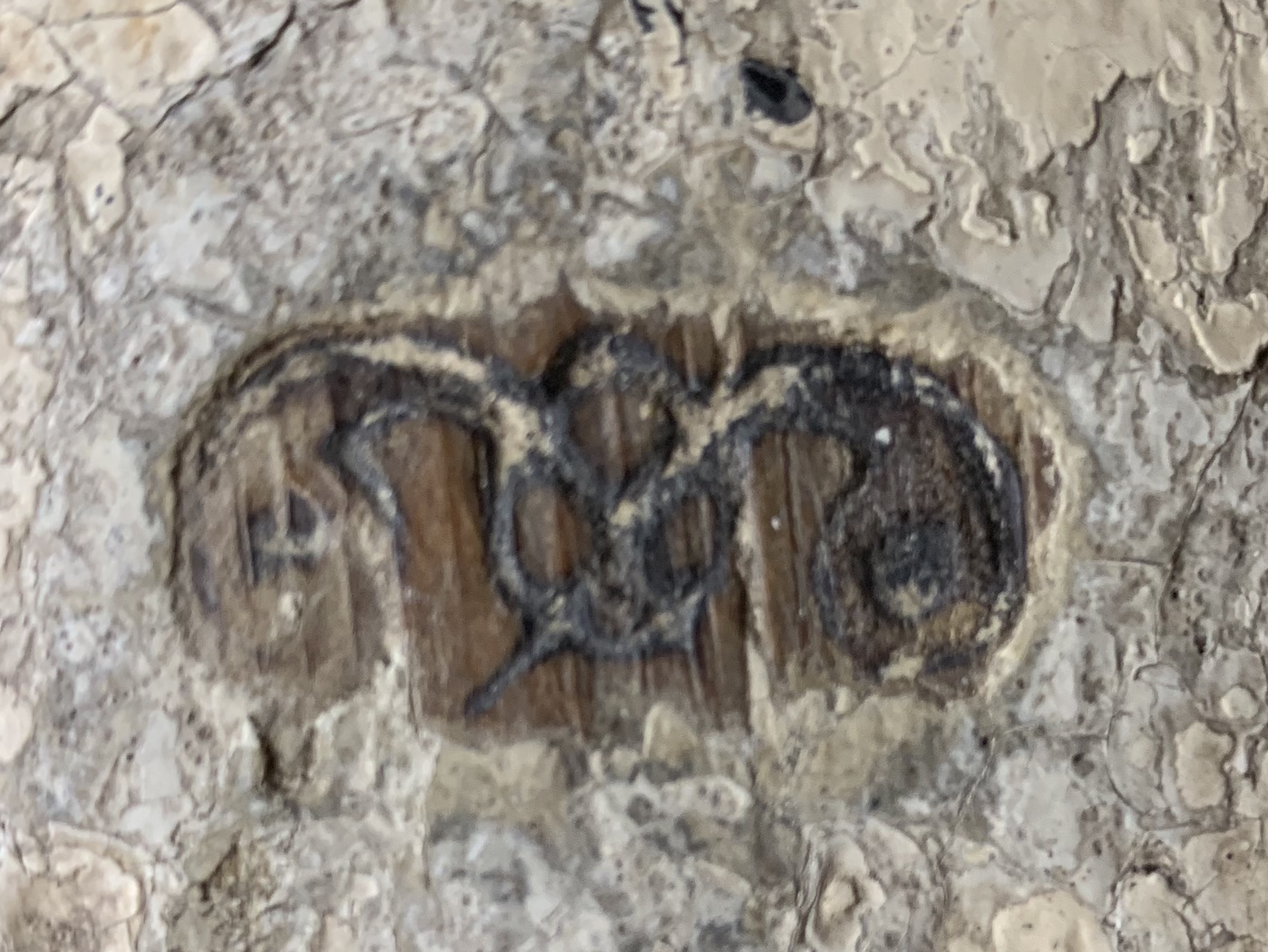
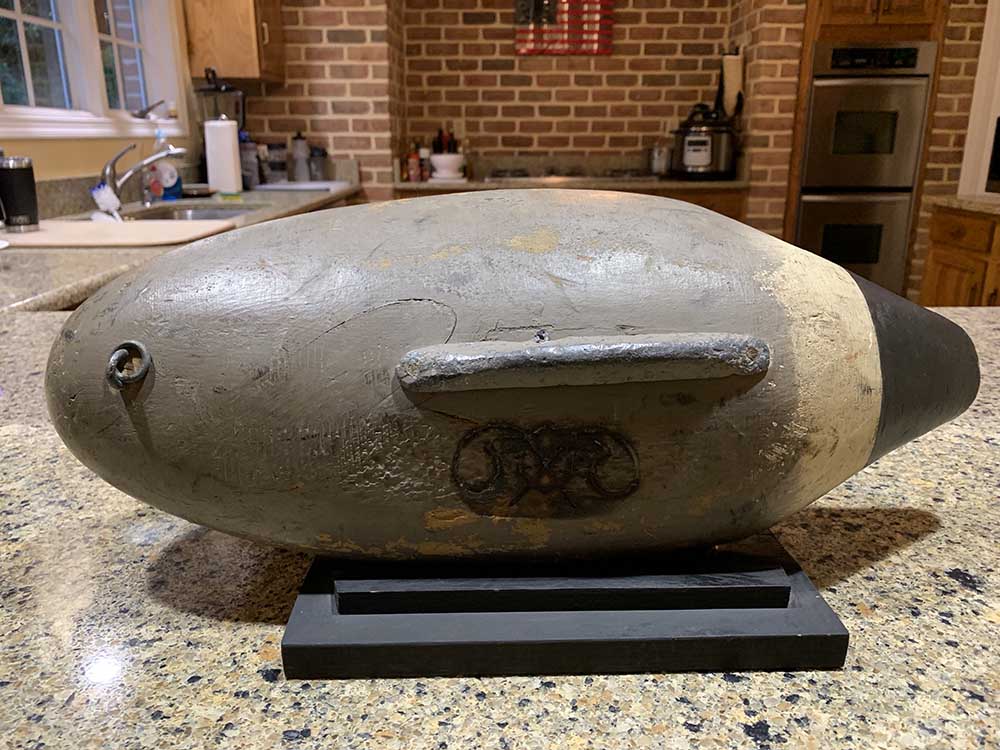
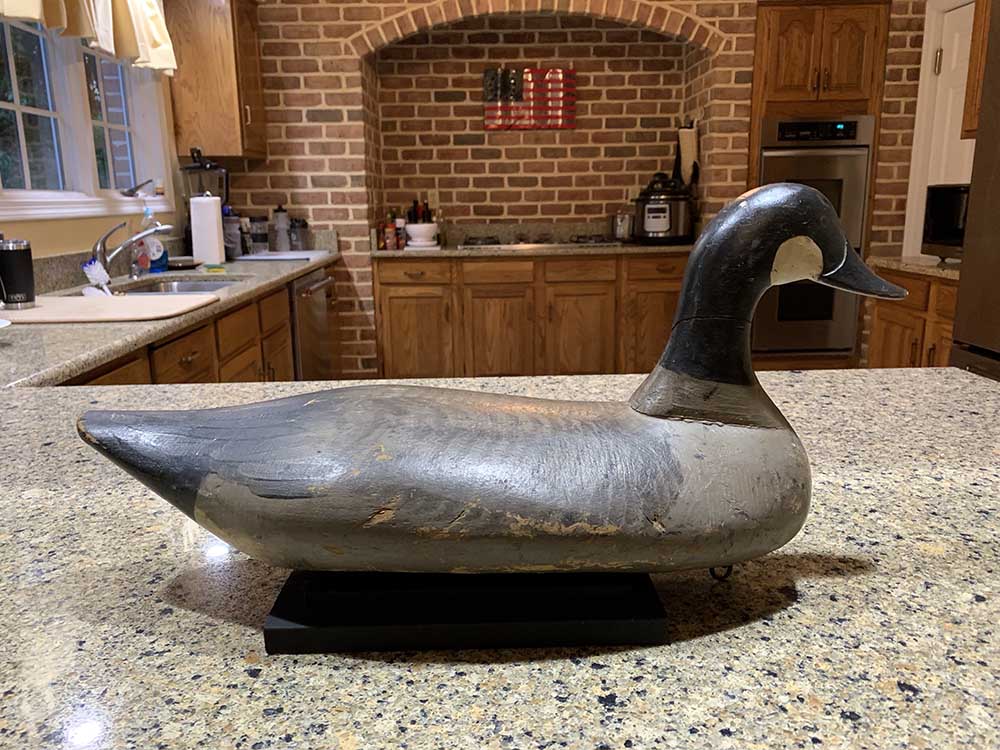
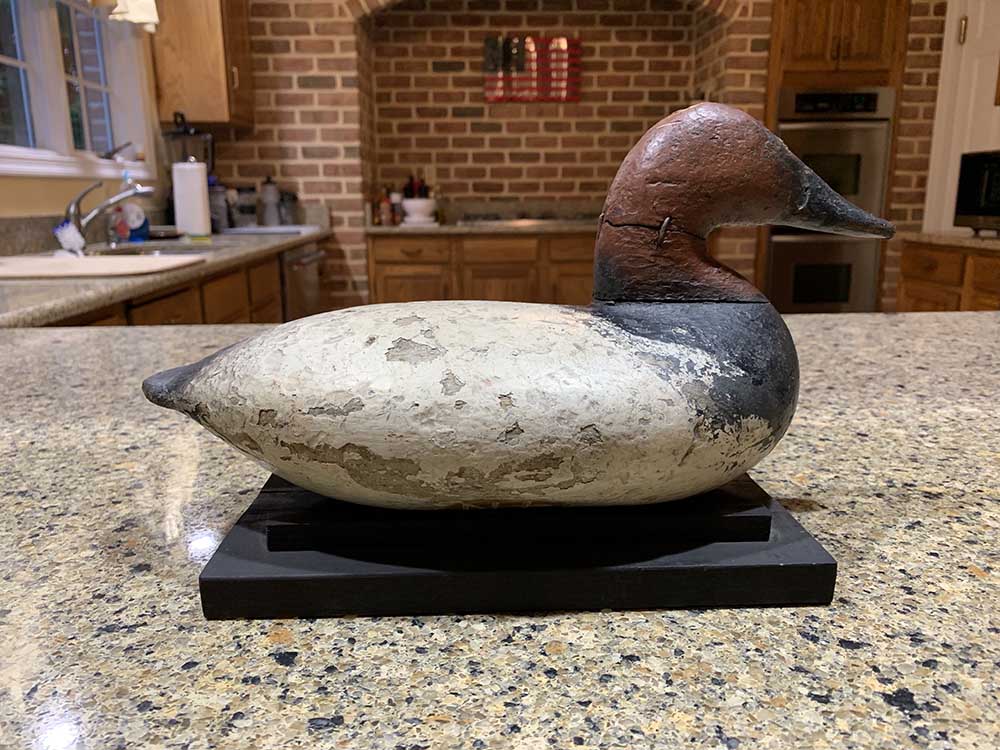
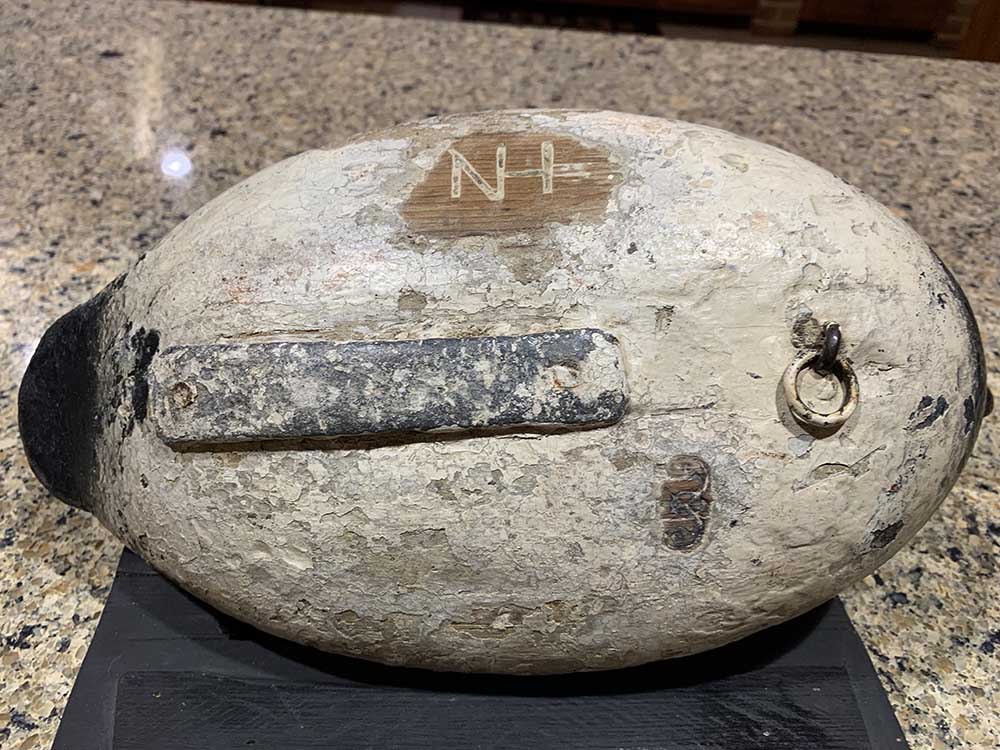
Physical description of brand:
The Edgewood Rod and Gun Club brand is the branch insignia of the U.S. Army Chemical Corps. The burned insignia/brand consists of a benzene ring, superimposed over two crossed retorts. This insignia was adopted by the newly created Chemical Corps in 1918 and officially approved in 1921. The branding irons used to brand the Club decoys most likely date to the 40s or 50s although the Club predates them. The smaller brand, primarily used on duck decoys, is 1” wide x ½” in height. The larger brand, primarily used on Canada goose decoys, is 3 ½” wide x 1 3/4” in height. My research indicates that the larger brand was used on at least 2 dozen Mitchell duck decoys.
Background:
The Edgewood Arsenal Rod and Gun Club was a club that included U.S. Army officers and Department of the Army civilian personnel stationed at the Arsenal as well as their families and guests. The club operated from approximately the 1920s until sometime not long after the Arsenal was combined with Aberdeen Proving Ground in 1971. In examining limited available records, it appears that in the earlier days of the Club, hunting may have been restricted to members of the Officer’s Mess at Edgewood Arsenal. This could also have been due to wartime since these records date to the early 1940s.
The land area that comprised Edgewood Arsenal, now known as Aberdeen Proving Ground South, was previously home to some of the most famous and prestigious waterfowl gunning clubs and private gunning shores of the 1800s and early 1900s. These included: a portion of the Bartlett and Hayward gunning shore on both Lauderick Creek and the Bush River; Maxwell Point, the gunning shore of John Cadwalader who owned the majority of the Gunpowder Neck land; the Philadelphia Ducking Club located at the mouth of King’s Creek on the Bush River; the Hurst family gunning shore on the Bush River; the Sunshine Club of which little is known at this time; the San Domingo Farm Club between Reardon Inlet and Canal Creek on the Gunpowder River; the Grace’s Quarter Club on the western shore of the Gunpowder River; and finally, the famous Carroll’s Island Ducking Club at the mouth of the Gunpowder River fronting the Chesapeake Bay. Most of these gunning shores were available to the members of the Edgewood Rod and Gun Club although some areas may have been closed down periodically due to testing and other military operations. It’s also been directly related to me that Poole’s Island, although not generally open to the Club at large, was gunned on a limited basis at the pleasure of the Commanding General, Edgewood Arsenal.
The majority of the decoys in the Club rig were made by R. Madison Mitchell and Paul Gibson. Gibson also served with the Fire Department on Edgewood Arsenal, and retired as its Chief in 1965. Decoys by other Upper Chesapeake Bay makers may also be found with this brand. These other decoys came to be part of the rig in a couple of ways. Members could draw 50, 100, or 150 decoys at the beginning of the season. They were turned-in in groups of 50 at a time. If a decoy broke away in rough weather, it was rarely recovered. If decoys had been lost, members replaced them with another decoy. When the Club would purchase new decoys for the rig, members would sometimes trade an old decoy of their own for a new decoy from the Club rig. The Club repainted the rig in the off-season and if a decoy was found to be without a brand (usually old birds added as previously described), it was branded with the Club brand. The club had two branding irons- a smaller iron for duck decoys, and a larger iron for goose decoys. All of the examples of Canada goose decoys with this brand that I’ve seen are Gibson geese. William (Bill) Kennedy, who tended to the rig in the off-season for many years, told me that he had personally branded a couple of dozen Mitchell duck decoys with the larger brand as well.
The Edgewood Arsenal Rod and Gun Club brand has acquired a number of names in the decoy collecting community that are technically and/or historically incorrect. These include: the “Poison” brand, the “Skull and Crossbones” brand, and the “Aberdeen” brand. Additionally, this brand has been referred to as the Ordnance Corps brand. It’s easy to understand why this occurred given the histories of Aberdeen Proving Ground and Edgewood Arsenal. Aberdeen Proving Ground was the home of the Army Ordnance Corps, and Edgewood Arsenal was the home of the Army Chemical Corps. The two bases merged in 1971. There was no Rod and Gun Club (or other officially recognized club) using branded decoys on Aberdeen Proving Ground prior to the merger. Reports of decoys branded with the Ordnance Corps insignia have been noted by collectors, but I’ve never seen an example in over 20 years. If there are decoys branded with the Ordnance Corps branch insignia (metal shell and flame), the brand is more than likely a personal brand of an officer of the Ordnance Corps. It’s also been proffered that decoys by Paul Gibson branded with the “FD” brand were from a fire department club on Edgewood Arsenal. Bill Kennedy, a former member of the Club whose father was a principal volunteer with the Club for approximately 30 years, firmly stated that there was no other club on Aberdeen Proving Ground or Edgewood Arsenal using branded decoys.
Other Brands on this decoy: John Graham drake Canvasback duck decoy with Edgewood Arsenal Rod and Gun Club brand and the Howard Nichols (Conjoined “HN”) brand. Howard Nichols was a market gunner from Elkton, MD.
This brand has been identified on the following decoys:
| Decoy | Maker | Species | Sex | Other Brands on Decoy |
| Madison R. Mitchell | Canvasback | Drake | ||
| Madison Mitchell | Canvasback | Hen | ||
| R. Madison Mitchell | Redhead | Drake | ||
| Paul Gibson | Redhead | Hen | ||
| Paul Gibson | Goose | N/A | ||
| Unknown Cecil County Carver | Canvasback | Drake |
References/Sources: Personal collection including maps; duck and goose decoys; photos; and copies of Club records. Personal interviews with former Club members and DA Civilian employees including: William (Bill) Kennedy (Dependent / Club member 1955-1968) , Steven English (DA Civilian / hunted Edgewood 1973-2004), and William Brankowitz (DA Civilian / authority on Chemical Corps and Edgewood history). Additional information and interviews with the Aberdeen Post Historian, Jeffrey Smart, contributed to this narrative.
Initial Contributor: Kevin S. Peel
Additional Contributors:
